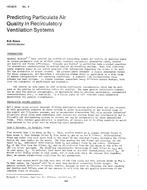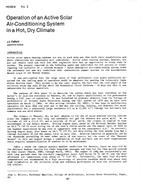-
-
Available Formats
- Options
- Availability
- Priced From ( in USD )
-
Available Formats
-
- Immediate download
-
$16.00Members pay $7.00
- Add to Cart
Customers Who Bought This Also Bought
-

HO-82-06-4 -- Predicting Particulate Air Quality in Recir...
Priced From $16.00 -

HO-82-08-2 -- Operation of an Active Solar Air-Conditioni...
Priced From $16.00 -

HO-82-17-1 -- Improved Operator Interface Techniques
Priced From $16.00 -

HO-82-01-3 -- Heat Pump Water Heaters with a Comparison t...
Priced From $16.00
About This Item
Full Description
Because air-source heat pump heating capacity and efficiency decrease as the outdoor air temperature drops, an auxiliary heat source is employed when the structure's heating demand exceeds the ability of the heat pump to supply it. The auxiliary heat source is usually electric strip heaters with a coefficient of performance (COP) of one. For this reason, extracting more heat from outdoor air at a COP greater than one, when building heating demand is greater than the heat pump can supply, becomes a desirable improvement goal for heat pumps. The use of variable compressor displacement, provides this capability. Refrigerant density can be varied instead of compressor displacement as described in a U.S. patent issued to Schwind.' This entailed using a mixture of R-13B1 and R-12 with a multistage distillation column in the refrigerant circuit, operated so that R-12 (bp -30°C) rich mixtures could be circulated during periods of low heating demand and R-13B1 (bp -58°C) rich mixtures during periods of high heating demand. Undoubtedly the cost and complexity of such a system have prevented its commercial use.
The potential benefit from effecting a one stage distillation was reported previously by the author.2 That study suggested that when the refrigerant charge was a mixture of R-1381 and R-152a, air-to-air heat pump capacity could be increased a worthwhile amount during periods of low outdoor temperature by collecting liquid in the accumulator. Compressor capacity was increased, because the stored liquid was richer in the higher boiling R-152a, thereby making the circulating composition richer in the lower boiling, high density R-1381.





